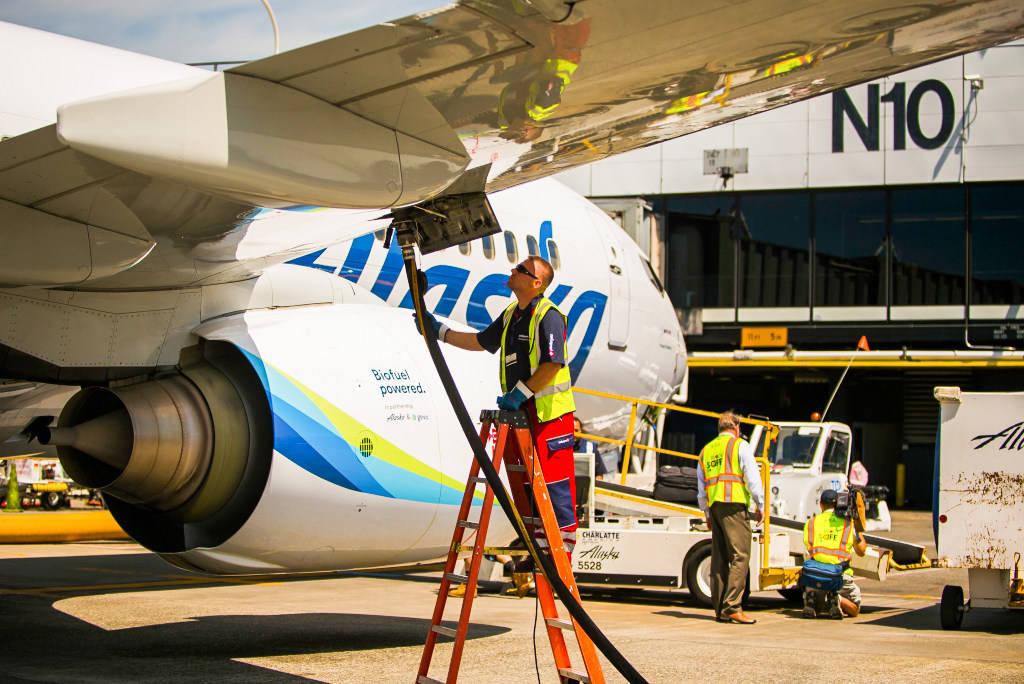As Earth Day is upon us, Alaska Airlines has announced a series of commitments and partnerships intended to make its aircraft cleaner, aiming at net-zeroing its emissions by 2040.
The announcement comes a week after the Seattle-headquartered airline announced a partnership with SkyNRG, a Dutch company, as they look to standardize production and use of sustainable aviation fuel, a fuel made from renewable products.
“There’s a lot of smart people that are working on this,” said airline external affairs manager for Alaska Airlines Tim Thompson in a phone interview. “Especially in the state of Alaska, there’s a strong push to reduce the carbon emissions.”
Aviation fuel is a major source of carbon emissions worldwide, according to the Federal Aviation Administration. Adoption of SAF will lower emissions, Thompson said. Alaska Airlines has been flying aircraft using blends of SAF for more than a decade, Thompson said. Adoption of SAF is intended to reduce greenhouse emissions by 80% and particulate matter by 90%, the airline said in a news release.
“The whole basis of SAFs is that it’s going to make for cleaner flights. That’s what it all comes down to,” Thompson said. “At Alaska Airlines, we’re committed to this.”
SkyNRG is currently working on developing the technology to turn solid waste into SAF, Thompson said.
“That is basically what they bring to the table: bringing the technology to create the facilities to transfer municipal waste into a usable product,” Thompson said. “For us on the other side, we’d be the recipient of that product, to be able to continue flying and reduce the carbon emissions.”
Such technologies would likely be concentrated in hub aviation facilities like Seattle, Thompson said, making it unlikely that Juneau will see a facility that turns trash into aviation fuel in the near future.
Future emissions goals
Alaska Airlines also announced a number of other steps it’s taking on its path to reducing greenhouse gas emissions, stated as the company’s most important contribution to environmental action, on Wednesday, April 21. Among those steps include signing the the Climate Pledge, an Amazon-founded organization intended to bring companies together to meet Paris Climate Agreement goals 10 years ahead of stated goals.
“At Alaska Airlines, we know that travel can make a big difference in people’s lives,” said Alaska Airlines CEO Ben Minicucci, in the news release. “Air travel connects us to our friends and families, helps us understand one another, and helps communities across the globe grow and thrive. But we know that to live our purpose, creating an airline people love, we must operate every day in a way that cares for both people and our planet. That’s why we’ve set out on this bold path to reduce our climate impact near and long term.”
Alaska Airlines lined out five particular areas of focus on this path: efficiency, SAF, novel propulsion systems, carbon offsetting technologies and fleet renewal.
“We have one of the youngest fleets,” Thompson said. “The technology that’s going into engines is leaps and bounds from where it was 10-20 years ago.
Use of the recently recertified Boeing 737-MAX increases per-seat fuel efficiency by 22%, according to Alaska Airlines. Additionally, Alaska Airlines intends to drastically reduce on-the-ground emissions through electric ground vehicles and other innovations to reduce unnecessary engine use, Thompson said. Other hardware improvements include shore power hookups at gates and winglets and improved navigation tech aboard the planes, according to the news release.
“We know that setting ambitious goals, measuring our progress — and then holding ourselves accountable — is the key to real progress,” said Alaska Airlines vice president of public affairs and sustainability Diana Birkett Rakow in a news release.
• Contact reporter Michael S. Lockett at (757) 621-1197 or mlockett@juneauempire.com.

